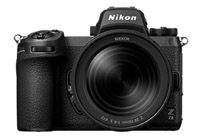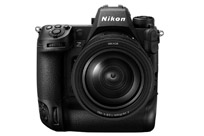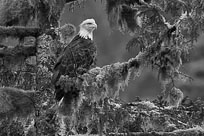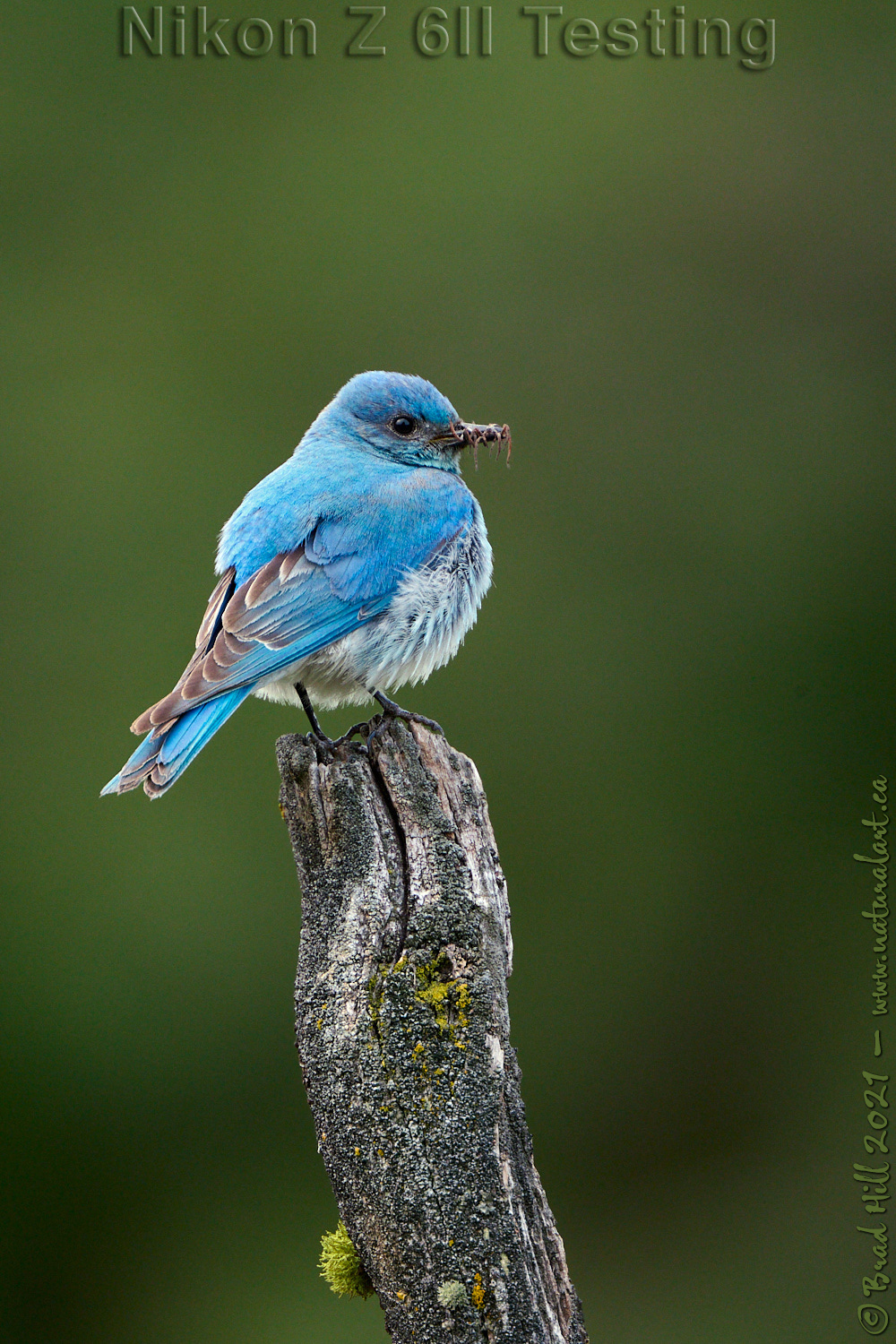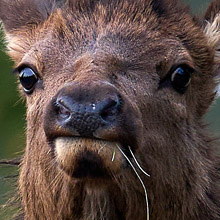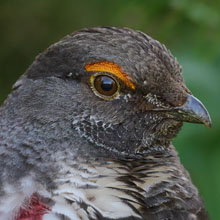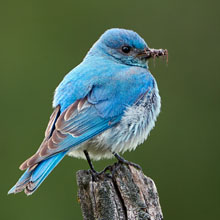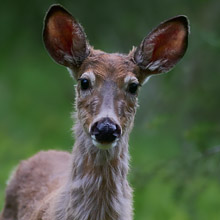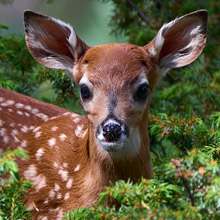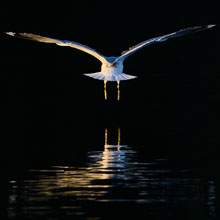Availability: Undetermined - Enquiries?
In the Field
Z 6II Testing - Male Mountain Bluebird on Breakfast Duty. Findlay Creek Region (East Kootenays), British Columbia, Canada. May 29, 2021.
This is my ninth gallery post detailing my experiences with shooting wildlife using the Nikon Z 6II. In this case I was shooting a pair of Mountain Bluebirds feeding nestlings when I had the opportunity to do some impromptu (but very real world) ISO testing on the Z 6II. I have already systematically tested the ISO performance of the Z 6II against both the Z 7II and the D6 (reported in my 24 March 2021 blog entry but most experienced shooters know that real world ISO performance varies significantly between scene "types". So whenever I get a good opportunity to shoot "real world" tests I nab them.
One reason I'm fixated on fully sussing out the ISO performance of the Z 6II is that it now seems almost certain that the coming Z 9 will be a high resolution camera (in the 50 MP range) and, owing to that resolution, it will lack the extreme ISO performance of Nikon's current D6 DSLR flagship. For me this means I may end up shooting my Z 6II in tandem with a Z 9, with the thought that the Z 9 will be my go-to camera EXCEPT when I'm in need of shooting at ISO's of about 6400 and higher.
And...these days we also have one more variable to consider when evaluating the "usable" ISO range of any particular camera - in the last year or so several software makers have come out with much better noise reduction software than we've had access to in the past. So knowing how far you can push the ISO of a given camera and get acceptable images AFTER using the latest noise reduction software is information that's helpful for me (and presumably others) to know in the field.
So...what did I do? Long story short, when I was shooting this male Mountain Bluebird - and given the equipment I was using and the ambient lighting conditions I was under - I determined that the "optimal" combination of settings to get the best possible image at the moment meant shooting at ISO 2200. But, because the Mountain Bluebird was almost "frozen" in position I had the time to capture a second nearly identical shot at what I think of as the highest I would EVER shoot my Z 6II at - ISO 12800. I then processed the shots in Capture One using the EXACT same settings and adjustments with one exception - in the final two steps of the ISO 12800 shot I removed ALL noise reduction that was to be applied in Capture One and, instead, I performed all noise reduction on the image using Topaz DeNoise AI 3.1. Relatively large versions of each image can be downloaded and examined using the links below.
The net result? Topaz DeNoise AI did a pretty good job. If you compare image noise and image detail there's not too much difference between the ISO 2220 and the ISO 12800 shots (and note that the slightly sharper tail feathers on the ISO 12800 shot are a function of the smaller aperture I used on that image to "get to" ISO 12800). Of course, as you crank up ISO on any camera things other than noise change, including reductions in color depth, dynamic range, and tonal range. If you look closely at these two images you'll notice slight color and tonal differences. But the differences are so slight that anyone with a moderate amount of experience in post-processing could largely negate them.
My own take home lesson? Because of advances in current noise reduction software I'm confident that I can squeeze AT LEAST one stop more of ISO performance out of my Z 6II (and presumably most any camera). This translates into me feeling comfortable jacking up the ISO by one full stop in the field. So this means that I'll be able to shoot my Z 6II at ISO 12800 or even slightly higher - and still get very usable images. Because I almost never shoot at ISO's greater than this anyway, I'm left more sure that my Z 6II will be a competent "alternate" camera to my Z 9 when I am forced to shoot at crazy ISO's.
Here's two interesting shots to compare. The first bluebird shot was captured at ISO 2200 and fully processed (including noise reduction) in Capture One. The second bluebird image was captured at ISO 12800 and also processed in Capture One, but all noise reduction on this image was performed using Topaz DeNoise AI 3.1:
• Male Mountain Bluebird on Breakfast Duty - ISO 2200: Download 2400 pixel image (JPEG: 1.9 MB)
• Male Mountain Bluebird on Breakfast Duty - ISO 12800: Download 2400 pixel image (JPEG: 1.5 MB)
ADDITIONAL NOTES:
1. This image - in all resolutions - is protected by copyright. I'm fine with personal uses of them (including use as desktop backgrounds or screensavers on your own computer), but unauthorized commercial use of the image is prohibited by law. Thanks in advance for respecting my copyright!
2. Like all photographs on this website, this image was captured following the strict ethical guidelines described in The Wildlife FIRST! Principles of Photographer Conduct. I encourage all wildlife photographers to always put the welfare of their subjects above the value of their photographs.
Behind the Camera
Z 6II Testing - Male Mountain Bluebird on Breakfast Duty. Findlay Creek Region (East Kootenays), British Columbia, Canada. May 29, 2021.
Compressed RAW (NEF) 14-bit format; ISO 2200.
Nikon Z 6II paired with Nikkor 180-400mm f4E plus TC-20EIII (2x) teleconverter (total focal length of 800mm). Supported on Jobu Killarney tripod with Jobu HD Mk IV gimbal head. VR on and in Sport mode. Single Area AF area mode.
1/200s @ f9; -0.67 stop compensation from matrix-metered exposure setting.
At the Computer
Z 6II Testing - Male Mountain Bluebird on Breakfast Duty. Findlay Creek Region (East Kootenays), British Columbia, Canada. May 29, 2021.
RAW Conversion to 16-bit PSD file (and JPEG files for web use), including all global and selective adjustments, using Phase One's Capture One Pro 21. Global adjustments on this image were limited to tweaks to the highlights and whites. Selective local adjustments performed using Capture One Pro's layers and masking tools. In this case selective adjustments were made on 6 separate layers and included one or more tweaks to brightness, colour (via the Color Editor), clarity, and shadows.
Photoshop modifications were limited to the insertion of the watermark and/or text.
Conservation
Z 6II Testing - Male Mountain Bluebird on Breakfast Duty. Findlay Creek Region (East Kootenays), British Columbia, Canada. May 29, 2021.
Species Status in Canada*: This species is not designated as at risk.
The Mountain Bluebird (Sialia currucoides) is a brilliantly coloured thrush found over much of western North America. Despite its name, it is NOT limited in distribution to mountain regions. In the early 1900's Mountain Bluebird populations plummeted due to loss of nesting habitat (natural cavities) due to the introduction of alien species, including House Sparrows and Starlings. An aggressive conservation effort in the form of the introduction of species-specific nest boxes worked and today bluebirds are common again.
This adult male Mountain Bluebird was photographed in the East Kootenays of BC, Canada. The area supports a strong population of Mountain Bluebirds and smaller population of Western Bluebirds.
One of the most fascinating things about the Mountain Bluebird is that the striking ultraviolet-blue coloration of feathers does not come from any type of pigment that has been incorporated into feathers. Instead, the source of the coloration is completely "structural" in that the microanatomy of the feather barbs in a way that primarily reflects ultraviolet and blue light while largely absorbing wavelengths of light that are perceived by humans as other colors (green, yellow, red, etc.). So what you are seeing is differentially reflected ultraviolet-blue light...NOT pigmentation!
*as determined by COSEWIC: The Committee on the Status of Endangered Wildlife in Canada








